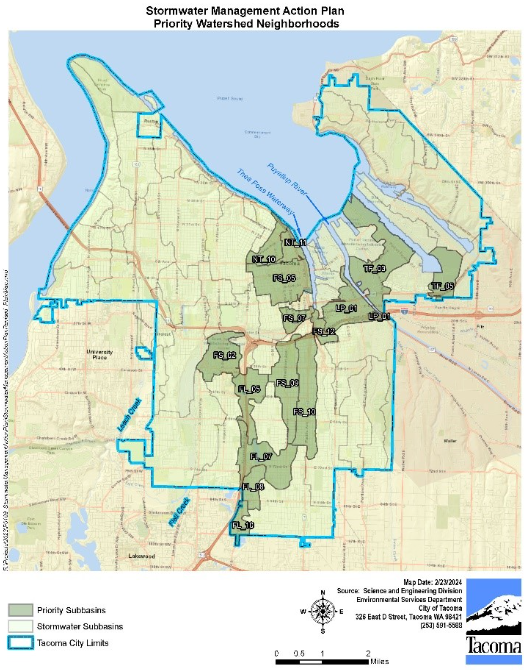Urban Waters Protection Plan
The Urban Watershed Protection Plan (UWP Plan) is a watershed plan developed by the City of Tacoma’s Environmental Services Department to identify and prioritize areas most in need of stormwater management actions. This UWP Plan builds a transparent strategy on how to rank problems with stormwater runoff in a prioritized way. Our actions will focus on solutions to protect people, property, and habitats from both stormwater flooding and pollution.
Our Goals:

Why do we need a watershed management plan in Tacoma?
Most of Tacoma’s stormwater flows directly into our waterways without any treatment. Simply put if It Hits the Ground it Hits the Sound! Tacoma’s future includes more residents, traffic, and climatic changes that put additional pressures on our environment.
The UWP Plan was based on input from the Interdisciplinary Team (IDT) to set transparently rank and make efficient and effective decisions to manage stormwater for healthy neighborhoods, green spaces and a thriving Puget Sound. The UWP Plan recommendations focus on both water quality and habitat benefits and Tacoma community and neighborhood needs.
View the UWP PLAN and APPENDICES
Take a look! Key chapters in the UWP Plan include:
- Chapter 3 and Appendix C provide descriptions of the City’s nine watersheds.
- Chapter 4 and Appendices G & H go over the Watershed Insights Tool, a GIS-based watershed model developed by this project to prioritize subbasins in the watersheds for stormwater solutions based on the watershed conditions and community needs.
- Chapter 5 lists the prioritized recommended actions
- Table 2 lists potential capital improvement projects for regional stormwater treatment facilities,
- Table 3 lists programmatic SWMP activity enhancements.
- Chapter 6 describes our Implementation Approach.
The UWP Plan shows the areas of the City with the most need of stormwater services.

The green sub-basins are portions of the watershed that had the highest score for priority of stormwater quality actions.
- Lower Puyallup (east Tacoma) sub-basin LP-01
- Flett Creek (south Tacoma) sub-basins: FL-10, FL-08, FL-07, and FL-05
- Thea Foss Waterway (Tacoma Mall, Lincoln District & Downtown) sub-basins: FS-12, FS-10, FS-09,
- FS-07, FS-05, and FS-02
- North Tacoma (Schuster/Stadium) sub-basins: NT-11 and NT-10
- Tideflats sub-basins TF-05 and TF-03
Implementing the UWP Plan Recommendations
Environmental Services staff will examine the feasibility of the recommended actions in Table 2 and 3 for implementation in the short-term (1 to 6 years) and the long-term (7-20 years). Improving stormwater quality through these actions depends on finding new funding, staff resources, partnerships, and other collaboration opportunities. Actions we will consider for implementation are discussed in greater detail in Section 5.
The City is now focusing efforts the subbasins and proposed solutions listed in Tables 2 and 3 of the UWP Plan. We are looking for opportunities for partnerships & funding over the next several years.
Additional Resources
Tacoma Land Use Designation Map
City of Tacoma Watersheds Map with Highlighted Waterbodies
Tacoma Watershed Map with Stormwater Outfalls
Where Does the Water Go Handout
What is a Watershed?
A watershed is an area of land that drains all streams, rainfall, and snowmelt to a common outlet such as a larger river, mouth of a bay, or any point along a stream channel. Watersheds are shaped and influenced by the natural landscape (like steep slopes, gulches, streams, wetlands, and shorelines), and also the built environment (like streets, sidewalks, parking lots, and the City’s stormwater collection system).
When pollutants enter our watershed through stormwater runoff contaminated with trash, fertilizers, oil, soaps, pet waste, or toxic chemicals, the negative effects can be measured and felt in every part of our environment.
Learn more about the nine watersheds in the the City of Tacoma, their unique geography, history, challenges, and opportunities for improvement: